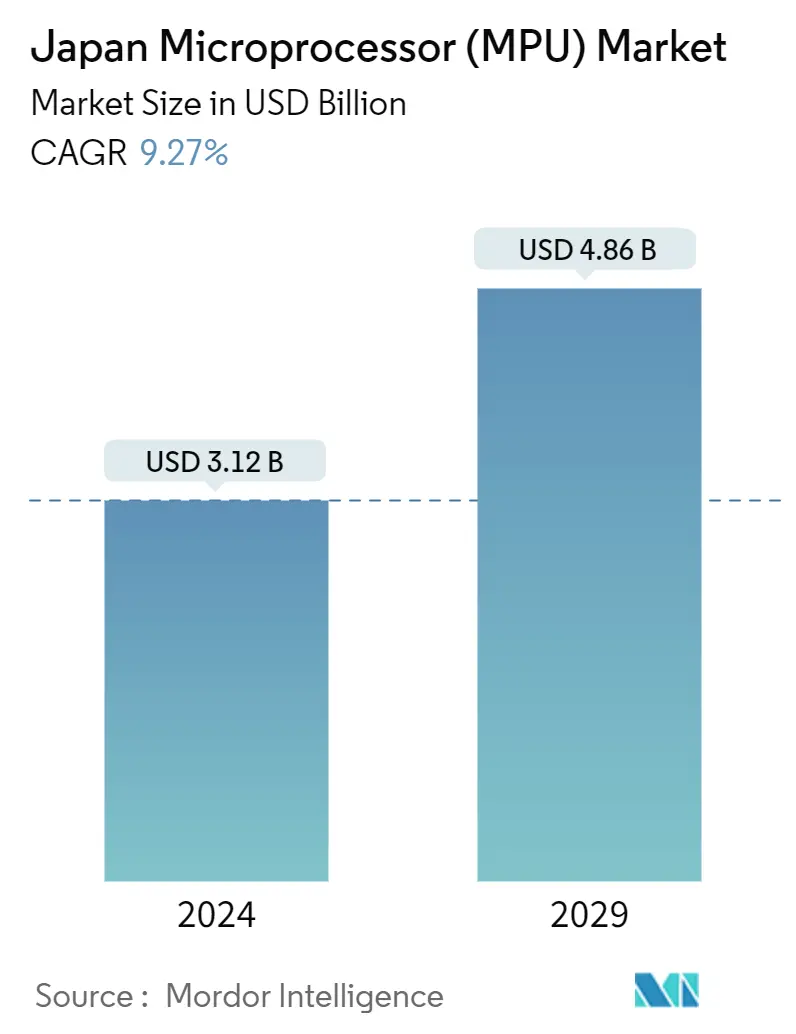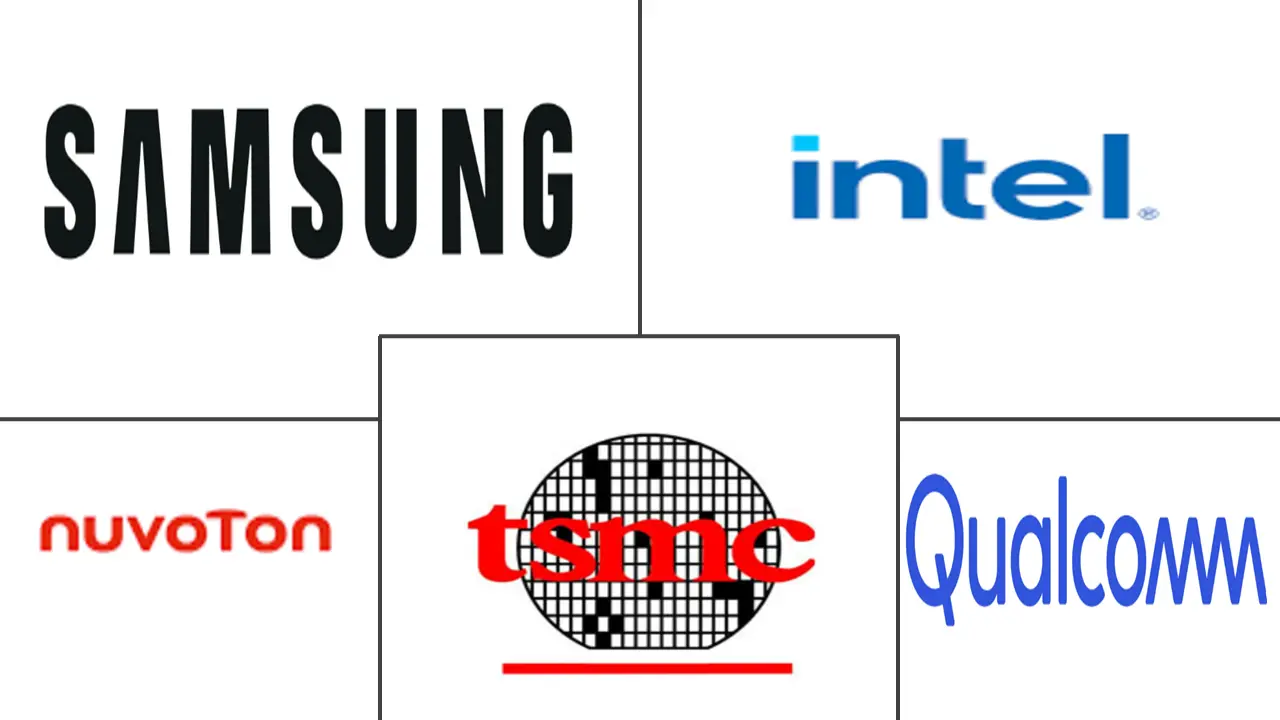Market Size of Japan Microprocessor (MPU) Industry

| Study Period | 2019 - 2029 |
| Base Year For Estimation | 2023 |
| Market Size (2024) | USD 3.12 Billion |
| Market Size (2029) | USD 4.86 Billion |
| CAGR (2024 - 2029) | 9.27 % |
| Market Concentration | Low |
Major Players
*Disclaimer: Major Players sorted in no particular order |
Japan Microprocessor (MPU) Market Analysis
The Japan Microprocessor Market size is estimated at USD 3.12 billion in 2024, and is expected to reach USD 4.86 billion by 2029, growing at a CAGR of 9.27% during the forecast period (2024-2029).
Japan has a strong microprocessor sector due to its emphasis on high-performance CPUs, cutting-edge design methods, and potent production skills, and the Japanese microprocessor sector has maintained its competitiveness.
- Japanese microprocessors have seen tremendous success in recent years in international markets. This has increased the demand for processors built in Japan, which has given Japanese semiconductor companies a chance to grow their operations in new markets.
- High-performance applications, including mobile computing, telephony, and imaging systems, are ideally suited for Japanese microprocessors. They are also widely utilized in commercial and industrial computer systems. Japanese microprocessors are frequently employed in consumer electronics products because of their performance and adaptability. This trend will drive the market growth in the projected period.
- Also, the other important factor encouraging the use of microprocessors is the rapid growth of the Internet of Things (IoT). IoT technologies make microprocessors possible because it is now technically and financially viable to collect data from a far larger variety of devices than was imaginable. Companies typically underestimate the complexity and volume of data created by IoT devices and platforms, necessitating the deployment of solutions to aid in managing and interpreting all of the data they are now gathering.
- According to the World Semiconductor Trade Statistics study, technologies make microprocessors possible; since the COVID-19 epidemic, the markets for Wi-Fi devices, video distribution, gaming consoles, and personal computers and tablets for telework have grown in the country. The sharp rise in data communications volume has also stimulated investment in data centers and telecommunications infrastructure, increasing demand for semiconductor devices.
- Even though some of these data requirements have decreased since the second half of 2021, capital investments have increased as economic activity has normalized, supporting demand for semiconductor devices.
Japan Microprocessor (MPU) Industry Segmentation
A microprocessor is a microcomputer's controlling unit built on a tiny chip and can communicate with other devices linked to it and carry out ALU (Arithmetic Logical Unit) activities. The control unit, register array, and ALU make up a microprocessor. ALU processes the information from memory or an input device using mathematical and logical procedures. The register array comprises accumulators B, C, D, E, H, and L-lettered registers. The computer's data and command flow are governed by the control unit.
Japan Microprocessor (MPU) Market is segmented by product (8-bit, 16-bit, 32-bit or greater), and by application (Consumer electronics, Enterprise (Computer and Servers), Automotive, Industrial). The market sizes and forecasts are provided in terms of value in USD for all the above segments.
| By Product | |
| 8-Bit | |
| 16-Bit | |
| 32-Bit or Greater |
| By Application | |
| Consumer Electronics | |
| Enterprise-Computer and Servers | |
| Automotive | |
| Industrial | |
| Other applications |
Japan Microprocessor (MPU) Market Size Summary
The Japan microprocessor market is poised for significant growth, driven by the country's robust emphasis on high-performance CPUs and advanced design methodologies. The sector has maintained its competitive edge, with Japanese microprocessors gaining substantial traction in international markets. This success has spurred increased demand for domestically produced processors, allowing Japanese semiconductor companies to expand their operations globally. The versatility of Japanese microprocessors makes them ideal for high-performance applications such as mobile computing, telephony, and imaging systems, as well as commercial and industrial computer systems. The rapid expansion of the Internet of Things (IoT) further fuels this demand, as the ability to collect and analyze data from a myriad of devices becomes both technically and economically feasible. This trend is expected to drive market growth over the forecast period.
The expanding consumer electronics sector, characterized by the growing popularity of smartphones, tablets, and gaming devices, is also a significant contributor to the market's expansion. The increasing demand for high-speed wireless internet connections, such as 5G, and the rise of IoT technologies necessitate the use of advanced microprocessors capable of handling complex data processing tasks. Japan's diverse technological landscape, including advancements in artificial intelligence, robotics, and cyber-physical systems, underscores the critical role of microprocessors in these developments. Key industry players, such as Intel, Samsung Electronics, and Renesas Electronics, are continuously innovating to meet the evolving market demands, further propelling the growth of the microprocessor market in Japan.
Japan Microprocessor (MPU) Market Size - Table of Contents
-
1. MARKET INSIGHTS
-
1.1 Market Overview
-
1.2 Industry Attractiveness - Porter's Five Forces Analysis
-
1.2.1 Bargaining Power of Buyers
-
1.2.2 Bargaining Power of Suppliers
-
1.2.3 Threat of New Entrants
-
1.2.4 Threat of Substitute Products
-
1.2.5 Intensity of Competitive Rivalry
-
-
1.3 Value Chain/Supply Chain Analysis
-
1.4 Impact of Marco Trends on the Market
-
-
2. MARKET SEGMENTATION
-
2.1 By Product
-
2.1.1 8-Bit
-
2.1.2 16-Bit
-
2.1.3 32-Bit or Greater
-
-
2.2 By Application
-
2.2.1 Consumer Electronics
-
2.2.2 Enterprise-Computer and Servers
-
2.2.3 Automotive
-
2.2.4 Industrial
-
2.2.5 Other applications
-
-
Japan Microprocessor (MPU) Market Size FAQs
How big is the Japan Microprocessor Market?
The Japan Microprocessor Market size is expected to reach USD 3.12 billion in 2024 and grow at a CAGR of 9.27% to reach USD 4.86 billion by 2029.
What is the current Japan Microprocessor Market size?
In 2024, the Japan Microprocessor Market size is expected to reach USD 3.12 billion.

